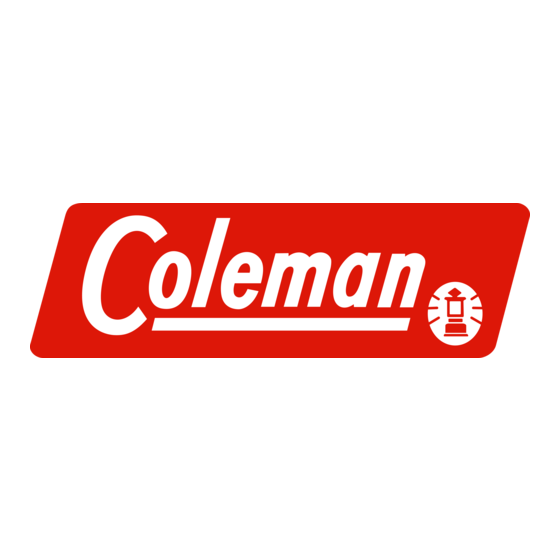
Subscribe to Our Youtube Channel
Summary of Contents for Coleman CDB767AZ1
- Page 1 CDB767AZ1 I N S T R U C T I O N S & O W N E R ’ S M A N U A L Please retain the packaging and instructions for further reference, as they contain important information.
- Page 2 With the proper care and handling of your telescope, you will enjoy years of viewing pleasure. As an astronomical device, the CDB767AZ1 telescope has been designed for both a beginner and advanced star gazer. It provides views of the moon and planets, as well as dozens of galaxies, star clusters, and nebulae.
- Page 3 PARTS LIST FOR CDB767AZ1 Telescope: A. Finderscope with bracket attached B. Accessory Tray, screws (3) & wing nuts (3) C. 2X Barlow D. Eyepieces (K9, K25) Eyepiece Cases (2) E. Yoke-to-Telescope Tube Attachment (2) F. Yoke G. Tripod leg attachment bolts and wing nuts H.
- Page 4 ASSEMBLY: 1) Carefully remove all parts from the cardboard cartons and lay them on a table, floor or other flat surface in order to take an inventory of all the pieces. Keep your box for storage or in case you ever need to ship your telescope. 2) Extend the legs, and lock each one at the desired height with the supplied tripod adjustment knob (See Fig.
- Page 5 4) Slowly loosen the tripod leg adjustment knobs and gently pull out the lower section of each tripod leg. Tighten the knobs to hold the legs in place. Spread the tripod legs apart to stand the tripod upright. Adjust the height of each tripod leg until the tripod head is properly leveled.
- Page 6 6) Locate the vertical fine adjustment rod. It is a chrome-plated metal rod about six inches long. Insert the smooth end into the chromed holder located on the side of the yoke (See Fig. 6). You may have to loosen the large plastic locking knob in order to insert the adjustment rod.
- Page 7 8) Insert the K25 eyepiece into the eyepiece holder (See Fig. 9). Tighten the small set screw to hold the eyepiece securely in place. (Fig. 9) 9) A 2X Barlow lens is supplied to double the basic magnifying power provided by any of the eyepieces.
-
Page 8: Finder Scope Alignment
5) You may need to repeat this procedure to ensure a perfect alignment. THE ALTAZIMUTH MOUNT: The CDB767AZ1 telescope is fitted with an altazimuth mount. “Alt” refers to altitude, the vertical movement of the telescope, while “azimuth” refers to the horizontal movement. -
Page 9: About Magnification
3x per mm of the aperture (for the CDB767AZ1, the aperture is 76mm) under good conditions. Thus, magnification of around 225x or less is ideal for a telescope with a 76mm diameter objective mirror (aperture) and is best for observing most celestial objects. - Page 10 ABOUT YOUR NEWTONIAN REFLECTOR TELESCOPE: Your telescope is a Newtonian reflector. Light enters the open end of the tube and travels down to the opposite end where it strikes a specially curved mirror, known as the primary mirror. The focused image is reflected back up the tube to a small, flat mirror near the open tube end, called the secondary mirror.
- Page 11 4) Remove the dust cap from the end of the telescope nearest the eyepiece holder and the finder scope. The dust cap consists of two pieces—a small, removable center piece and the large main cap (See Fig. 12). Both pieces should be removed (See Fig.
-
Page 12: Care And Cleaning Of The Optics
NOTE: Use of the 2X Brarlow lens with the 1.5 erecting lens is not recommended (See Fig.14.) (Fig. 14) The image erecting lens provides 1.5x magnification, which means that the K25 eyepiece will magnify objects from 28x to 42x when used in conjunction with the image erecting lens. - Page 13 If, after several attempts, you cannot remove the particles, take the telescope to an optical professional for cleaning. If you keep the dust caps on your telescope when it is not in use and avoid handling the lenses or mirrors, only minimal optical maintenance of your telescope should be required.
- Page 14 Jupiter is the largest planet in our solar system and the second brightest next to Venus. Jupiter has many moons, four of which are often visible through your telescope when viewing conditions permit. As you watch them throughout the evening, you will see that they change position relative to each other and to Jupiter.
-
Page 15: Frequently Asked Questions
K. FREQUENTLY ASKED QUESTIONS: 1) How far can I see? If you stand outside and look up at the night sky on a clear evening, you can see hundreds of stars without the aid of your telescope. The telescope is a light-gathering instrument that magnifies the view—providing significantly more detail and unveiling more stars, nebulae, and celestial objects. - Page 16 Elite Brands Inc. 40 Wall Street 61st Flr. New York, NY 10005 Tel: 1-800-441-1100 ©2018 ©2018 Elite Brands Inc., New York, NY 10005...




Need help?
Do you have a question about the CDB767AZ1 and is the answer not in the manual?
Questions and answers